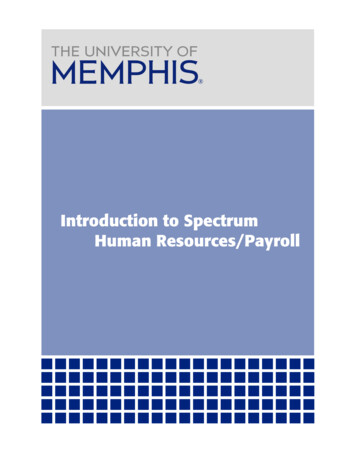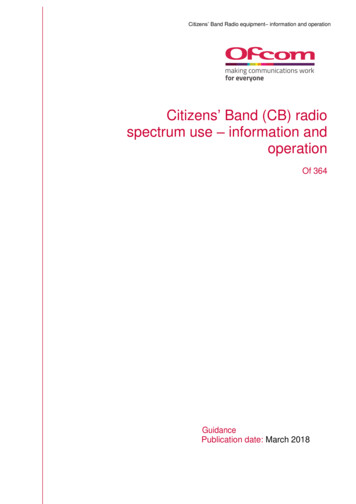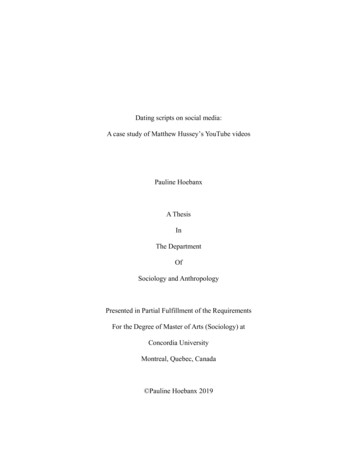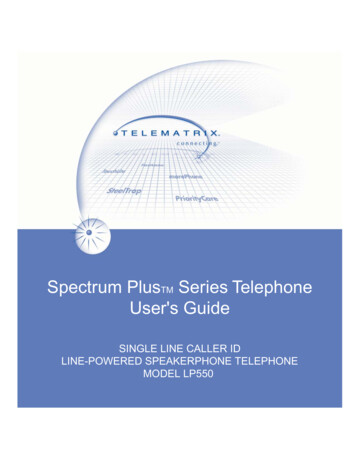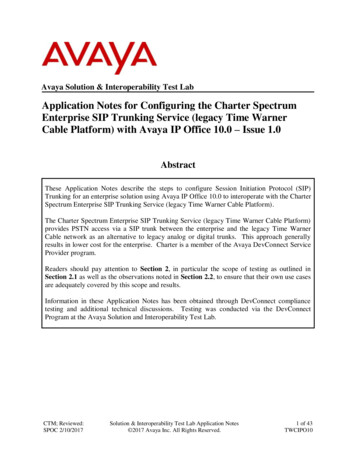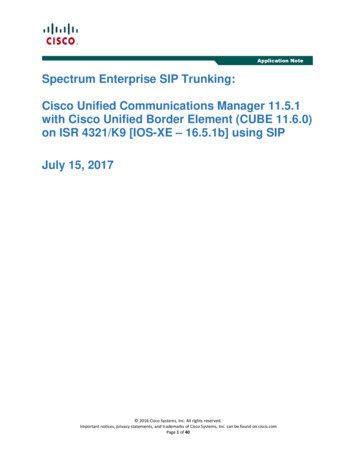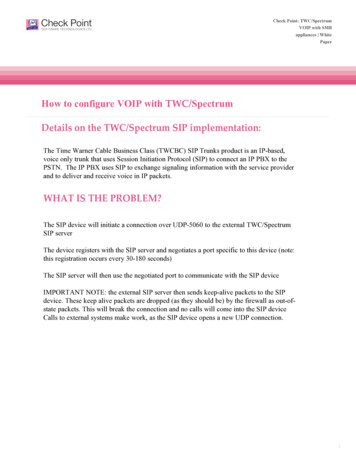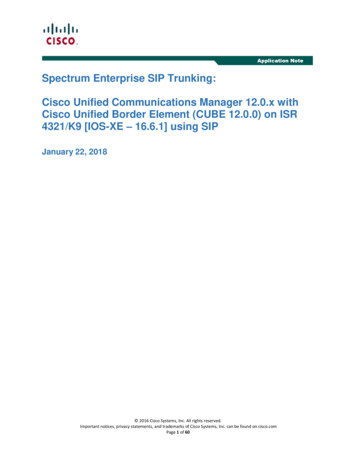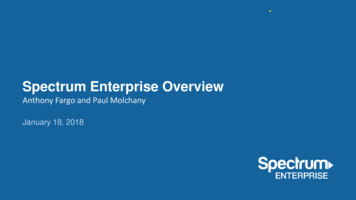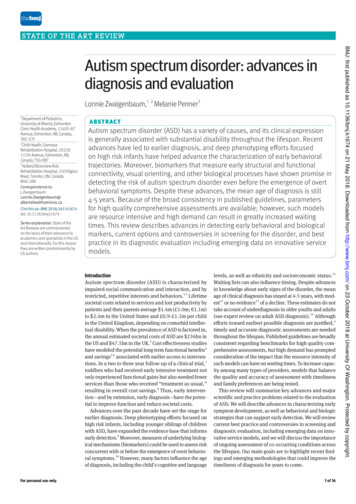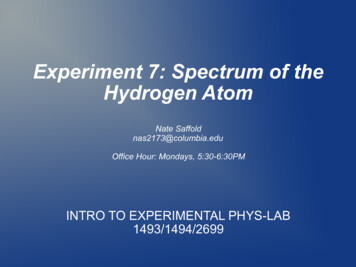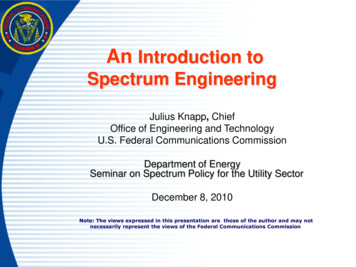
Transcription
An Introduction toSpectrum EngineeringJulius Knapp, ChiefOffice of Engineering and TechnologyU.S. Federal Communications CommissionDepartment of EnergySeminar on Spectrum Policy for the Utility SectorDecember 8, 2010Note: The views expressed in this presentation are those of the author and may notnecessarily represent the views of the Federal Communications Commission
Why We Are Here: Utility WirelessApplications Use SpectrumVoiceDispatcher to CrewsCrew to CrewEmergency Call“Talk Around”InterconnectTrunked OperationMutual Aid/InteroperabilityData: System Monitoring andControl, Reports and StatusMessagingTelemetry, ProtectiveRelayingSCADA (Supervisory Controland Data Acquisition)Automated Meter ReadingHome AutomationSecurityMobile/Personal DataComputer/TerminalApplicationsWireless LAN/WANConnectivityRemote Device MonitoringRobotics supportCommercial ServicesStatus MessagingWide Band Data and StaticImagingVideoSource: Utilities Telecom Council 2009 report:The Utility Spectrum Crisis – A Critical Need to Enable Smart Grids
Basic Concepts ofRadio Technology
A Basic Radio SystemAntennaAntennaTransmission LineTransmission LineTransmitterReceiverElectromagnetic wavesor radio signals propagateover the airwavesThe transmitter generates anelectrical signal and feeds it to anantenna by a transmission line.An antenna picks up the signalfrom the airwaves and passes it viaa transmission line to the receiver.
Radio Signal Characteristics1 wavelengthor 1 cycleAmplitude orsignal strengthA continuous waveor (CW) carrier wave (signal) Frequency number of cycles per second Hertz (Hz) 1 cycle per secondKilohertz (kHz) 1 thousand cycles per secondMegahertz (MHz) 1 million cycles per secondGigahertz (GHz) 1 billion cycles per second Wavelength (speed of light) / (frequency) Amplitude Signal strength or power
BandwidthfrequencyflowfhighBandwidth the amount of the radio frequencyspectrum occupied by an RF signalBW fhigh - flow
Conveying InformationModulation The information (voice, video, or data) is converted toan electrical signal that “modulates” a radio signal atthe transmitter and is “demodulated” at the receiver. Modulation is the systematic variation of thecharacteristics of one signal (radio frequency carrier)in accordance with the characteristics of anothersignal (information). Examples: AM, FM, OFDM, etc.
Radio Propagation Signals lose energy as they travel over theairwaves or other medium Like the ripples from a rock thrown in apond - - waves decrease in size withdistance Different propagation models used: Free space – line of sight Statistical models for urban, suburban, etc. As frequency increases, radio signalsbehave like light; more loss
Overview ofSpectrum Management
Spectrum Management “Radio Spectrum” is the range offrequencies from 3 kHz to 400 GHz The spectrum resource is finite, but isnever “exhausted” Spectrum Management: All activitiesassociated with managing this resource Allocating & assigning the spectrum;managing interference; enforcement
Frequency Allocations “Master Zoning Map” - The entire range of usable spectrum is dividedinto blocks or bands of frequencies that are “allocated” for particular radioservices: Mobile; Fixed; Broadcasting; Satellite; etc. Int’l Table of Frequency Allocations: Radio signals do not recognize boundaries World/Table is divided into three Regions U.S. Table of Frequency Allocations: Government exclusive bands (NTIA) Non-Government exclusive bands Shared bands Interference Protection Status: Primary - Fully protectedCo-Primary - First-in is protectedSecondary - Must protect primaryFootnotes to the table (S, US, G, NG)
U.S. Table of Frequency AllocationsAvailable at: http://www.ntia.doc.gov/osmhome/allochrt.html
A Simplified Spectrum Chart15 GHz SatelliteCommon Carrier Microwave1 GHz -Cellular Phones800 MHz UHF-TVLand MobileCoast Guard/HarborVHF-TV ch 7-13PoliceVHF MarineCivil Air PatrolAviation88108VHF-TV ch 2-6FM Broadcast (88-108 MHz)CBAmateur (Ham)Search & Rescue (SAR)400 MHz -150 MHz 108 MHz 54 MHz 27 MHz -1600 KHz -AM BroadcastMarine70 KHz -
All Spectrum Is Not Created EqualFrequency WavelengthInterestingPropertiesTypical Uses10 kHz30 km(20 miles)Wavespenetratesignificantdistanceinto waterCommunication withsubmarines100 kHz1000 kHz(1 MHz)10 MHz3 km (2 miles)300 meters(1,000 feet)30 metersIonospheric(100 feet)reflection3 meters(10 feet)30 cm (1 foot)100 MHz1000 MHz(1 GHz)10 GHz3 cm (1 inch)Higher rangesaffected byintense rainNavigationAM broadcastingCB radio,HF broadcastingFM broadcastingTV broadcastingCellular radio, top ofUHF TV bandSatellite TV,point-to-pointcommunications,radars
FCC’s Table of Frequency Allocations47 C.F.R. §2.106 (Sample)941-1429 MHz (UHF)Page 41International TableUnited States TableFCC Rule Part(s)Region 1Region 2Region 3Federal GovernmentNon-Federal GovernmentSee previous page for890-942 MHzSee previous page for928-942 MHzSee previous page for890-942 DMOBILE except aeronautical MOBILEmobileBROADCASTING S5.322942-960FIXEDMOBILEBROADCASTINGUS268 US301 US302 NG120US268 US301 US302 G2944-960S5.323Public Mobile (22)Fixed Microwave (101)S5.320944-960FIXEDNG120960-1215AERONAUTICAL RADIONAVIGATION960-1215AERONAUTICAL RADIONAVIGATIONS5.328S5.328 US224Public Mobile (22)International Fixed (23)Auxiliary Broadcast. (74)Fixed Microwave (101)Aviation (87)Complete Table Available at: http://www.fcc.gov/oet/spectrum/
Controlling InterferenceTransmitters operating on the same frequency need to beseparated by some distance to avoid “harmful interference”.UndesiredsignalThe desired signal must be somewhatgreater than the undesired signal toavoid interferencePropagation orPath LossDesiredsignalTransmitter AFactors such as transmitter power,Antenna height, propagation losses,& receiver characteristics determine size ofservice areaTransmitter B
Defining ―Harmful Interference‖And Why it MattersHarmful Interference. Interference which endangers the functioning ofa radio navigation service or of other safety services or seriouslydegrades, obstructs, or repeatedly interrupts a radio communicationservice operating in accordance with [the ITU] Radio RegulationsIncumbents and newcomers often have different view of “harmful”Why it matters - - determines viability of spectrum accessif radio were “audio” and were a basis for separation between homes - -Separation based onreasonable noise controlSeparation based onconservative noise control
Finding Spectrum for New ServicesImprove efficiency – packmore service in same space– Technical rules– Secondary marketsSharing:––––Re-use Frequencies ThroughGeographic SeparationGeographic separationFrequency coordinationOverlaysTime of useReallocation:– Remove or reduce allocationw/ no compensation– Reallocate and new licenseepays for relocation– Reallocate & pay forrelocation w/ auctionproceedsEarth Stations (Uplinks)and Fixed MicrowaveLinks Can Use the Same Frequencies ThroughAntenna DiscriminationExamples of Sharing
New Models: Dynamic Spectrum AccessAt any given location/time, much of the spectrum is ―unused‖Dynamic spectrum access or opportunistic use couldpotentially identify the ―unused‖ spectrum and radio canadapt itself to operate without causing harmful interferenceFCC Notice of Inquiry adopted November 30Dynamic AccessOr Smart RadioSpectrumUsersFrequencyRadio finds the holes andsizes itself to use them
Overview of FCC Rules20
FCC JurisdictionFCC manages non-federal spectrumNational Telecommunications & InformationAdministration (NTIA) manages federalspectrum– Advised by Interdepartmental RadioAdvisory Committee (IRAC)– Federal Agencies participate in IRAC:DoE, DoD, DoT, NASA, State Dept., etc.FCC works closely with federal agencieson a wide variety of issues
Licensed Radio ServicesBroadcastingSatellitePrivate Wireless–––––Public ile– Cellular– PersonalCommunications– Advanced Wireless– 700 MHz– Broadband RadioServiceFixed Wireless––PrivateCommon Carrier
Standards For LicensedRadio ServicesPrimarily focus oninterferencecontrolRules strive to betechnology neutral––––FCC generally has notregulated:FrequencyPower OutputBandwidth/ChannelsSpurious EmissionsOther:– RF Exposure– Hearing aidcompatibility– E-911––––Protocols (i.e. LTE, WiMAX)PerformanceReliabilityCompatibility
Unlicensed Devices: Part 15Part 15 provides for operation of low powerunlicensed radio transmittersOperating conditions: May not cause harmful interference Must accept any interference receivedPart 15 minimizes likelihood of interference by: Identifying permissible frequencies Limiting power very low levels Requiring equipment authorization
Unlicensed DevicesPart 15 provides for unlicensed devices: May not cause harmfulinterference and must accept any interference that may be received.Business & homenetworkingMetropolitan & CommunityNetworks – WISPsDevices for ConsumerAnd Business ApplicationsInternetAccessSubstationBroadband Over Power LinesGenerator25
Technical Standards forUnlicensed DevicesPrimarily focus is on interference controlOperating frequencies/restricted bandsPower/signal strengthOut-of-band and spurious emissionsIndustry has developed protocol standardswithin the framework of the rules: Wi-Fi,Bluetooth; Zigbee; Homeplug, etc.
TV White Spaces (TVWS) TV channels are “allotted” to cities to serve the local area Other licensed and unlicensed services also operate in the TVbands “White Spaces” are the channels that are “unused” at any givenlocation by licensed devices24LowPower TVNew York CityFull PowerTV Stations5WhiteSpace79WirelessMicrophonesEtc.Only for illustrative purposesWhiteSpacePhiladelphiaFull PowerTV StationsNonBroadcastspectrum3LowPower lessMicrophonesEtc.
Overview of TVWS RulesFixed and personal/portable devices allowed tooperate in the TV white spaces on an unlicensedbasisTo identify channels available for use, devicesmust:– 1) include a geolocation capability and– 2) provide their location to a database of protected radioservices at sends back a list of available channels at thatlocationDatabase will be established and administered bya third party operatorsRules also provide for devices that use spectrumsensing to identify available channels; separaterules and authorization path28
TVWS: Facilities to Be ProtectedFull power, low power, translator and Class ATV stations (also Canadian and Mexicanstations in border areas)Low power broadcast auxiliary (mostly wirelessmikes)Land mobile/CMRS (13 markets; public safety)Fixed broadcast auxiliary linksOffshore radio telephone service (Gulf region)Certain radio astronomy sitesAlso must protect:– Unlicensed wireless mikes used at eventvenues– MVPD and low power TV receive sites
TVWS Spectrum AvailabilityAvailable spectrum varies by locationIn rural areas many channels are availableIn big cities only a few channels may be availableExamples of availability in UHF channels 21 – 51 (Illustrative):New 4445464748495051Washington, 122232425262728Full Service DTVStation29303132333435Low Power TVStation3637Channel Open/Adjacent to TVChannel Open/ NotAdjacent to TV30
Equipment AuthorizationMulti-tiered equipmentauthorization program - many devices self-declaredMost transmitters must becertificated by FCC ortelecommunicationscertification bodyEquipment may not beimported or marketed untilcertificatedCheck label for FCC IDGrants of certificationavailable on FCC web siteSeehttp://www.fcc.gov/oet/ea/FCC Id: XXXYYYY
The National Broadband Plan32
GoalsCongress’s charge in the RecoveryAct led to the creation of theNational Broadband PlanCongress said that the plan should: “Ensure that all people of the United Stateshave access to broadband capability andestablish benchmarks for meeting that goal.” “[I]nclude . . . a detailed strategy forachieving affordability . . . and maximumutilization of broadband infrastructure andservice” “[I]nclude . . . an evaluation of the status ofdeployment of broadband service” “[I]nclude . . . a plan for use of broadband . . in advancing consumer welfare, civicparticipation, public safety and homelandsecurity, community development, health caredelivery, energy independence and efficiency,education, worker training, private sectorinvestment, entrepreneurial activity, jobcreation and economic growth, and othernational purposes.”PublishedMarch 16, 201033
GoalsWhy a National Broadband Plan?Because broadband is the great infrastructurechallenge of the early 21st centuryTranscontinental railroad(1860s)Rural electrification(1930s)Interstatehighways (1950s)Broadband34
GoalsGaps in the broadbandecosystem todayAvailabilitygap Fourteen million Americans do not have access to broadbandinfrastructure that can support today’s and tomorrow’s applications 93 million Americans do not have broadband at homeAdoption gapDigital skillsgapNationalpurposes gap Many Americans lack digital skills, even as many job openings areposted exclusively online The U.S. ranks in the bottom half of comparable countries on nearlyevery metric used to measure the adoption of health informationtechnology Most of the U.S. electric grid is not connected to broadband35
GoalsGoals of the NationalBroadband Plan Goal No. 1: At least 100 million U.S. homes should have affordable access toactual download speeds of at least 100 megabits per second and actual uploadspeeds of at least 50 megabits per second. Goal No. 2: The United States should lead the world in mobile innovation,with the fastest and most extensive wireless networks of any nation. Goal No. 3: Every American should have affordable access to robustbroadband service and the means and skills to subscribe if they so choose. Goal No. 4: Every American community should have affordable access toservice of at least 1 gigabit per second to anchor institutions such as schools,hospitals and government buildings. Goal No. 5: To ensure the safety of the American people, every firstresponder should have access to a nationwide, wireless, interoperablebroadband public safety network. Goal No. 6: To ensure that America leads in the clean energy economy, everyAmerican should be able to use broadband to track and manage their realtime energy consumption by 2020.36
Spectrum37
SpectrumSpectrum is the ―oxygen‖ thatwireless broadband needs to thriveConsumer AppsHungryDevices450XUnit Sales in the US (millions)Smartphone sales to overtake standard phones by tandard Wireless TelephonesSource: TIA, Wilkofsky Gruen Associates from “TIA’s 2009 ICT Market Review and Forecast”.Mobile PCSource: CiscoNational PurposesCivic EngagementTelemedicinePublic SafetySmart Grid38
SpectrumTrends in demand and supplysuggest a looming spectrum gapForecasted mobile data traffic in North AmericaMobile broadband spectrum pipeline*In 2004 MDS/ITFS was rebanded to create the EBS/BRS bandNeed totransformspectrum policyto meet wirelessbroadbanddemands39
SpectrumPolicy changes neededfor a range of issuesGapsIssuesLack of transparency inallocation and utilization Current allocation and utilization data is largely unattainableand often esotericFew spectrum reallocationtools FCC needs at its disposal multiple tools for reallocatingunderutilized spectrum to next-generation usersInsufficient capacity forbroadbandSuboptimal backhauldeploymentAccess models limited Wireless broadband growth is causing network strain thatwill intensify with next-generation technologies Spectrum can take years to reclaim Growing need for expensive backhaul services, includingmicrowave Access lacking in terms of capacity, flexibility andaffordability Opportunistic access to spectrum is limited to certain bands Demand for unlicensed spectrum among key stakeholdersPolicy scope too bounded There is no framework for identifying future spectrum bandsand needs Coordination of multiple domestic and internationalstakeholders40
SpectrumFramework for recommendations123Expand incentives andmechanisms available toreallocate or repurposespectrumEnsure greatertransparency in allocationand utilizationMake more spectrumavailable Incentive auctions Spectrum dashboard Within 10 years, 500 megahertztotal Spectrum fees54Facilitate deployment ofspectrum for wirelessbackhaul More flexible rules Bands under considerationinclude Broadcast TV, MSS, WCSand AWS6Expand opportunities forinnovative spectrum accessmodelsIncreasecomprehensiveness ofspectrum policy New unlicensed allocation Work with NTIA Opportunistic use Tribes R&D International41
Unleash More Spectrum for Mobile BroadbandThe Plan recommends that the FCC make 500 MHz newly available for broadbanduse within the next ten years, of which 300 MHz of high-value spectrum between225 MHz and 3.7 gigahertz (GHz) should be made newly available for mobile usewithin five years.BandKey Actions andTimingMegahertz Made Available for NPRM2010—L-Band andBig LEO 012/13—Auction2015—Bandtransition120AWS 2/32D BlockMobile SatelliteServices (MSS)Broadcast TVTotal3300
Energy and the Environment43
Energy and theenvironmentAs a platform for innovation, broadband helpsconsumers understand and manage their energy use44
Smart Grid er ReadingManage the Grid: Control Generation,Distribution and Storage of EnergyManage Dynamically Efficient Use ofEnergy by Homes and BusinessesA wide assortment of technologies - - wired, licensed and unlicensed- - are available for these and other Smart Grid applications45
FCC Organization
OET Organization ChartOffice of Engineering and TechnologyJulius P, Knapp, ChiefAlan Stillwell, Deputy ChiefIra Keltz, Deputy ChiefRon Repasi, Deputy ChiefBruce Romano, Associate ChiefAdministrationXenia Hajicosti, Assistant ChiefPolicy & Rules DivisionGeraldine Matise, ChiefMark Settle, Deputy ChiefElectromagneticCompatibility DivisionLaboratoryDivisionWalter Johnston, ChiefRashmi Doshi, Chief
OET’s Core ResponsibilitiesProvide independent technical analysis and advice to theChairman, Commissioners, Bureaus and OfficesSpectrum Management––Manage the Table of Spectrum AllocationsDevelop & coordinate technical rulesResponsibility for:––––Part 2: Frequency Allocations and Radio Treaty Matters; General Rules andRegulations (particularly equipment authorization & marketing rules)Part 5: Experimental Radio Service (Other Than Broadcast)Part 15: Radio Frequency DevicesPart 18: Industrial, Scientific & Medical EquipmentAuthorization of Service––Equipment Authorization ProgramExperimental Radio LicensingTechnical Research and Analysis
ConclusionQuestions andAnswers
Applications Use Spectrum Voice Dispatcher to Crews Crew to Crew Emergency Call “Talk Around” Interconnect Trunked Operation Mutual Aid/Interoperability Data: System Monitoring and Control, Reports and Status Messaging Telemetry, Protective Relaying SCADA (Supervisory Control and Data
